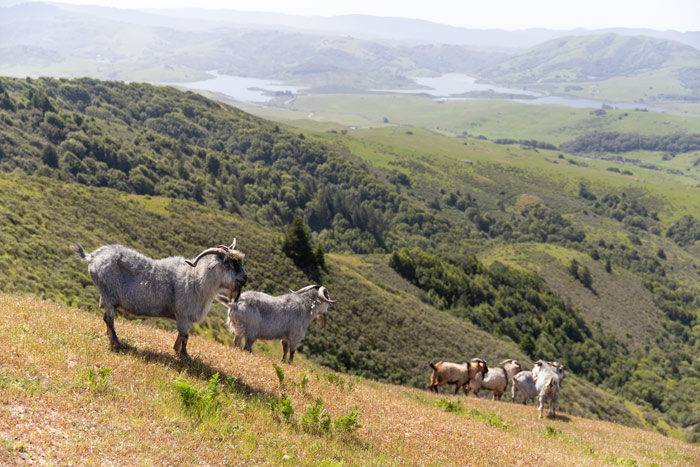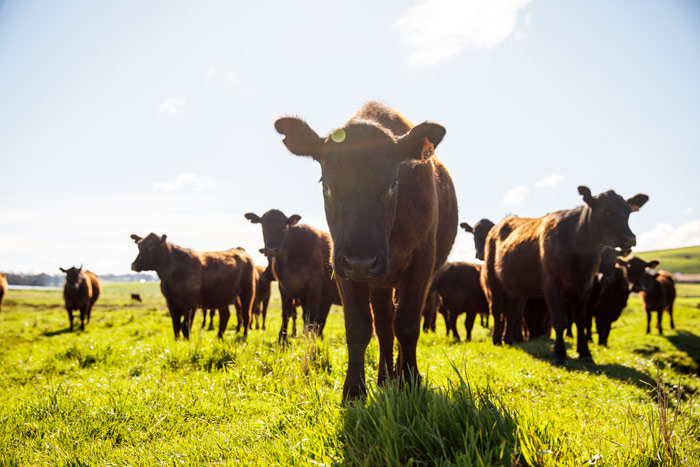What Role Can Agricultural Lands Play in Wildfire Protection?
August 15, 2022
We are all too familiar with the catastrophic wildfires that have engulfed much of the state in recent years. It has been difficult to watch as so many fellow Californians experience a devastation unseen in our lifetimes, the realities of decades of fire suppression and a rapidly warming climate.
In Marin County, well-managed rangelands and farmlands can help protect the entire region from uncontrolled wildfires. Through MALT’s conservation easements, we are ensuring the land we protect from the threat of development remains in agricultural production in perpetuity. Not only is this work helping to capture and store planet-warming gasses from the atmosphere; it is also one of our best defenses against the threat of catastrophic fire.
How do agricultural lands help with fire protection?
Well-managed rangelands — and the key phrase here is well-managed — reduce fire risk by diminishing fuel loads (flammable material like grass & leaves) through livestock grazing. Grazing animals shorten grass height and prevent shrub encroachment, which reduces the excess fuel loads that stoke massive wildfires. As a recent UC Cooperative Extension, (UCCE) Marin County, blog post quoted UCCE specialist Lynn Huntsinger: “We need to make livestock into firefighters. Constant, deliberate, targeted grazing is needed for fire management.”
In addition, well-managed rangelands and forests maintain healthy habitat structure and biodiversity, encouraging water retention in our soils that can act to slow a fire’s progress.
 Goats are among the best animals at helping mitigate the risk of catastrophic wildfire. As browsers, preferring to eat what’s available at eye-level, they help control the brush that, once ignited, acts like a ladder carrying the fire to the treetops.
Goats are among the best animals at helping mitigate the risk of catastrophic wildfire. As browsers, preferring to eat what’s available at eye-level, they help control the brush that, once ignited, acts like a ladder carrying the fire to the treetops.
At the regional level, urban development and the fragmentation of land creates numerous threats, including loss of habitat and biodiversity, increased erosion, and — as described by Lynn Huntsinger in the book Into the Wild: Vegetation, Alien Plants, and Familiar Fire at the Exurban Frontier — higher risk of catastrophic wildfires.
Without active management and the implementation of grazing or prescribed fire — two of the most common land management tools in the western U.S. — grasses, shrubs, and trees will continue to increase fuel loads, creating a dense tinder box — the ingredients for uncontrolled wildfire.
In a very real sense, preservation of agricultural land that’s stewarded with climate-beneficial practices is a form of fire protection. Our agricultural operations and their animals are key to maintaining balance in our grassland ecosystems that, in turn, protect our communities from uncontrolled wildfires.
Stewarding agricultural land in Marin County with climate-beneficial practices is essential to addressing climate change and its effects, including greater fire risks. Fire protection across Marin County’s agricultural lands helps protect the entire county. Conversely, failing to address fire risks anywhere in the county increases the overall risk.
So where does MALT fit into this picture?
Well-stewarded agricultural land is at the heart of MALT agricultural conservation easements. Pioneered by MALT 40 years ago—and replicated by organizations across the United States—the agricultural conservation easement is a tool used to protect farmland and ranches from development and keep them in productive agricultural use forever.
MALT agricultural conservation easements aren’t just handed out to anyone who requests one. They require that protected properties continue to operate as working farmland that provides sustainably grown food to Marin and Bay Area communities—while also safeguarding wildlife habitat and the ecological health of the region.
 Well-managed grazing animals shorten grass height and prevent shrub encroachment, which reduces the excess fuel loads that stoke massive wildfires.
Well-managed grazing animals shorten grass height and prevent shrub encroachment, which reduces the excess fuel loads that stoke massive wildfires.
Landowners partnering with MALT via agricultural conservation easements must agree to steward the land in ways that ensure the ranching activities actively improve key conservation targets, such as reducing invasive species, rehabilitating creek habitat, improving water quality and soil health, and becoming more fire resilient.
MALT monitors each protected property’s operations to ensure compliance with the requirements of the easement—which adds important accountability to agricultural management practices.
Wildfire prevention and protection must be addressed on multiple fronts. MALT takes seriously the role of protection and conscientious stewardship of agricultural land and wants to make sure it’s included in the mix.